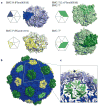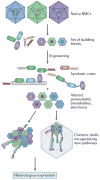Bacterial microcompartments
- PMID: 29503457
- PMCID: PMC6022854
- DOI: 10.1038/nrmicro.2018.10
Bacterial microcompartments
Abstract
Bacterial microcompartments (BMCs) are self-assembling organelles that consist of an enzymatic core that is encapsulated by a selectively permeable protein shell. The potential to form BMCs is widespread and found across the kingdom Bacteria. BMCs have crucial roles in carbon dioxide fixation in autotrophs and the catabolism of organic substrates in heterotrophs. They contribute to the metabolic versatility of bacteria, providing a competitive advantage in specific environmental niches. Although BMCs were first visualized more than 60 years ago, it is mainly in the past decade that progress has been made in understanding their metabolic diversity and the structural basis of their assembly and function. This progress has not only heightened our understanding of their role in microbial metabolism but is also beginning to enable their use in a variety of applications in synthetic biology. In this Review, we focus on recent insights into the structure, assembly, diversity and function of BMCs.
Conflict of interest statement
Competing interests statement
The authors declare no competing interests.
Figures





Similar articles
-
Protein stoichiometry, structural plasticity and regulation of bacterial microcompartments.Curr Opin Microbiol. 2021 Oct;63:133-141. doi: 10.1016/j.mib.2021.07.006. Epub 2021 Jul 31. Curr Opin Microbiol. 2021. PMID: 34340100 Review.
-
Advances in the bacterial organelles for CO2 fixation.Trends Microbiol. 2022 Jun;30(6):567-580. doi: 10.1016/j.tim.2021.10.004. Epub 2021 Nov 19. Trends Microbiol. 2022. PMID: 34802870 Review.
-
Carboxysomes: The next frontier in biotechnology and sustainable solutions.Biotechnol Adv. 2025 Mar-Apr;79:108511. doi: 10.1016/j.biotechadv.2024.108511. Epub 2024 Dec 26. Biotechnol Adv. 2025. PMID: 39732444 Review.
-
Innate and engineered attributes of bacterial microcompartments for applications in bio-materials science.J Mater Chem B. 2023 Jun 7;11(22):4842-4854. doi: 10.1039/d3tb00098b. J Mater Chem B. 2023. PMID: 37194349 Review.
-
Engineering nanoreactors using bacterial microcompartment architectures.Curr Opin Biotechnol. 2018 Jun;51:1-7. doi: 10.1016/j.copbio.2017.09.005. Epub 2017 Oct 13. Curr Opin Biotechnol. 2018. PMID: 29035760 Free PMC article. Review.
Cited by
-
Cryo-EM structure of Mycobacterium smegmatis DyP-loaded encapsulin.Proc Natl Acad Sci U S A. 2021 Apr 20;118(16):e2025658118. doi: 10.1073/pnas.2025658118. Proc Natl Acad Sci U S A. 2021. PMID: 33853951 Free PMC article.
-
Probing the Internal pH and Permeability of a Carboxysome Shell.Biomacromolecules. 2022 Oct 10;23(10):4339-4348. doi: 10.1021/acs.biomac.2c00781. Epub 2022 Sep 2. Biomacromolecules. 2022. PMID: 36054822 Free PMC article.
-
Characterisation of the Effect of the Spatial Organisation of Hemicellulases on the Hydrolysis of Plant Biomass Polymer.Int J Mol Sci. 2020 Jun 19;21(12):4360. doi: 10.3390/ijms21124360. Int J Mol Sci. 2020. PMID: 32575393 Free PMC article.
-
Metabolic pathway assembly using docking domains from type I cis-AT polyketide synthases.Nat Commun. 2022 Sep 21;13(1):5541. doi: 10.1038/s41467-022-33272-2. Nat Commun. 2022. PMID: 36130947 Free PMC article.
-
Effect of Charge Distribution on the Dynamics of Polyampholytic Disordered Proteins.Macromolecules. 2022 Oct 25;55(20):8987-8997. doi: 10.1021/acs.macromol.2c01390. Epub 2022 Oct 12. Macromolecules. 2022. PMID: 38250712 Free PMC article.
References
-
- Kerfeld CA, Heinhorst S, Cannon GC. Bacterial microcompartments. Annu Rev Microbiol. 2010;64:391–408. - PubMed
-
- Kerfeld CA, Melnicki MR. Assembly, function and evolution of cyanobacterial carboxysomes. Curr Opin Plant Biol. 2016;31:66–75. - PubMed
-
- Turmo A, Gonzalez-Esquer CR, Kerfeld CA. Carboxysomes: metabolic modules for CO2 fixation. FEMS Microbiol Lett. 2017;364 - PubMed
Publication types
MeSH terms
Substances
Grants and funding
LinkOut - more resources
Full Text Sources
Other Literature Sources
Molecular Biology Databases
Miscellaneous

